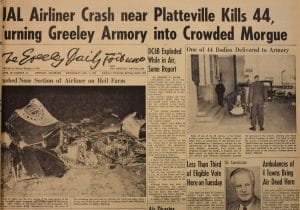On November 1, 1955, the front page of the Greeley Tribune contained stories of the previous night’s Halloween parties and pranks. It was a much different story later that night when United Air Lines flight 629 exploded mid-air and crashed outside of Platteville, Colorado. On November 2nd, the front page was covered with images of twisted burning metal. None of the 44 people on board survived.
As the investigation into the cause of the crash began, the idea that someone intentionally destroyed the plane was considered highly unlikely. However, United hired an explosives expert who determined that something in the baggage compartment had exploded. This resulted to one of the largest investigations led by the FBI up to that date. Interviews of people connected to the deceased took place in an effort to find a motive. One individual began to stand out; John Gilbert “Jack” Graham, owner of a Denver drive-in restaurant. His mother and business partner, Daisie King, was on the plane.
It was discovered that Graham had a history with the law and was suspected of blowing up his own restaurant to collect insurance monies. Graham’s wife said she had seen her husband go to the basement, where King was staying, with a wrapped Christmas present just before leaving for the airport. She did not ask her husband about the gift and did not know if he had given it to his mother.
On November 13th, the FBI arrested Graham after a tedious interview, wherein he initially denied that he had bought a present for his mother, but later admitted he had purchased a gift, wrapped the gift in Christmas paper, and planned on hiding it in his mother’s luggage. He claimed to have told his wife about the gift but not of his plans to hide it. The FBI accused him of placing a bomb on the plane. He calmly denied the accusation and agreed to let the police and FBI search all his belongings and property.
The FBI informed his wife that she had committed a federal crime when she lied about her knowledge of the package. Fearful, she stated Jack told her not to say anything about the package, and that she knew he had plans to hide it in his mother’s suitcase. She signed a statement that the agents took back to show her husband. In addition, the search yielded a $37,500 flight insurance policy for King, hidden in a chest at the Graham’s house, dated November 1st, with Jack as the beneficiary.
Using the signed statement from Graham’s wife, the FBI hinted that they would charge her with a crime if Graham did not cooperate. Graham then admitted that the “gift” was actually a timer and 25 sticks of dynamite that he placed in his mother’s suitcase. It was at this point that the FBI ran into a problem. This was the first time anyone had blown up an airplane, and there was no law in place prohibiting the act. The most the FBI could charge him with was “interference with a national defense utility,” because there was an active serviceman on board the plane. This charge was considered not enough, and the FBI decided to transfer the case to the State of Colorado where Graham could be charged with the first degree murder of King, which had a maximum penalty of death.
The lack of sufficient punishment for this crime lead the FBI and Civil Aeronautics Administration to discuss how to prevent such a tragedy in the future. This included physical inspection of luggage and air freight, x-ray machines for suspicious packages, and posting of uniformed guards in airports. In addition, Colorado Senator Gordon Allot introduced a bill making sabotage of a commercial aircraft a federal crime punishable by death. This bill passed before Graham’s trial and his sentence was carried out.
Graham again began to deny his involvement with the bombing and claimed that his confession was forced. His original line of defense was an insanity plea. Five separate doctors deemed him sane, but that he was “an exceedingly immature individual who has exhibited poor judgment and who tends to act on impulses.”
After a suicide attempt, he again admitted that he was responsible for the bombing. He confessed through tears to his doctors that he decided to put the bomb on the plane after his mother refused to stay with him for Thanksgiving, and that he did not feel remorse for the other people on the plane.
The evidence was overwhelming, and Graham was convicted and sentenced to death. The event constituted the largest mass murder in US history up to that date.
Originally published in Greeley Tribune, November 12, 2011
Written by Angela Alton, former Assistant Exhibits Curator
